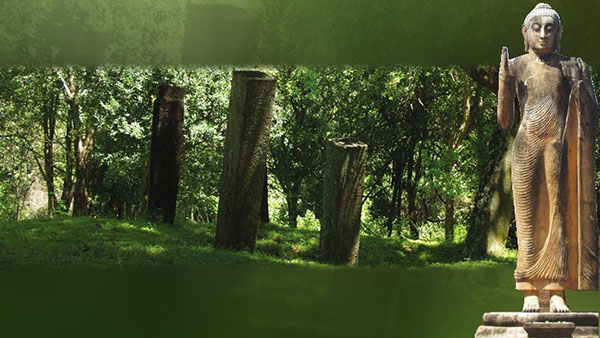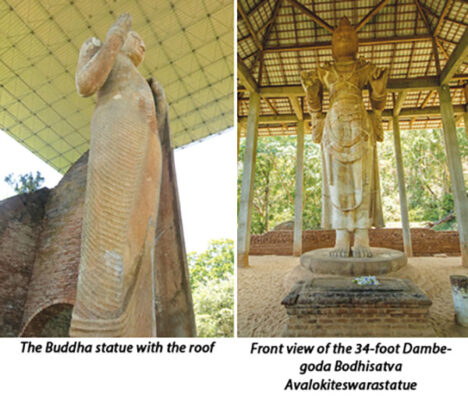A quiet moment at Maligawila-BY MAHIL WIJESINGHE

Source:Sundayobserver
I had a long cherished ambition to photograph the massive standing Buddha statue of Maligawila, one day. That day finally dawned on January 15, 2008, a day before the gruesome LTTE bomb attack that took many innocent lives in the Maligawila, Okkampitiya and Niyadella villages.

The day before the bomb exploded, I travelled along the same road and saw women bathing in the Kumbukkan Oya. Some people stood at the bus halt for the bus to take them to their destinations. In Okkampitiya, villagers were seen selling vegetables at the village fair, gem merchants waited for the miners, and farmers rode bicycles loaded with goods.
People carried on with their daily activities. It was an area of tranquil beauty with lush green paddy fields and tall kumbuk trees, spanning across the plains, providing the much needed shade.
I was back at Maligawila during a recent visit to Moneragala and saw the place with a new facelift. A roof had been erected over the Buddha statue.
Although the statue was protected from the rain and the sun, the natural setting for a photograph had been destroyed as we could not shoot a good image with the roof. Fortunately, I had taken many shots of the statue before the erection of the roof.
Awe-inspiring
Maligawila, a fifty-minute drive from Wellawaya is the site of the most awe-inspiring massive Maligawila Buddha statue similar to the Avukana Buddha statue and is said to be one of the tallest free-standing Buddha statues in Sri Lanka. It stands 42 feet on its pedestal. This 7th century colossus dominates a 40-acre landmass and is at the centre of a huge temple complex. The statue has been resurrected rejoining its broken pieces.
Slumped to the ground in three pieces when the former President, the late Ranasingha Premadasa first saw it, it was restored to its former majesty by Ven Mapalagama Vipulasara and was open to the public in September 1991.
In close proximity is the 34-foot Dambegoda Bodhisatva statue of Avalokiteswara. The gigantic Avalokiteswara Bodhisatva statue which had fallen many years ago, tattered in fragments lying in the tentacles of the dense jungle was restored to its former glory on September 1, 1990.
This statue was also unveiled by the former President the late Ranasinghe Premadasa. The Avalokiteswara Bodhisatva statue is 16 metres high, and dates back to the same period of the Buduruwagala Bodhisatva statues the around 9th The – 10th century AD. (Buduruwagala was featured in the Sunday Observer edition last week).
It was broken into many pieces, and some parts were found through excavations, such as parts of a pilimage with beautiful carvings. The ancient chronicles attribute the construction of the Maligawila Buddha statue, the Bodhisatva Avalokitesvara statue and the complex of the image house to King Aggabodhi III of the 7TH century AD.
According to archaeologists, a hospital for the blind and the sick had been built in the blindman’s village called Kanagama in the precincts of Avalokiteswara, around Maligawila, Dambegoda. The blind still worship here in the hope of the restoration of their sight.
Mahayana Buddhism
Such beliefs were on par with the doctrine of Mahayana Buddhism, as the Avalokitesvara was the saviour of mankind and healer of the sick, and the disabled.
The restoration of the Bodhisatva statue had been carried out with the assistance of experts from Thailand, France, Germany and Sri Lanka.
At present, after the restoration of the Maligawila-Dambegoda archaeological sites, this historic place has become very popular with an influx of pilgrims and visitors enroute to Kataragama. The present the place has been developed with rows of boutiques and stalls teeming with activity.
These sites lie close to the northern boundary of the Ruhunu (Yala) National Park where the ruins are excavated and restored, amid the untouched jungle which has provided a parkland of forest canopies. Every restored site is named according to its history and the period to which it belonged.
The pathway leading to Maligawila and Dambegoda is well maintained with copious forest shade. Most visitors take the route along the Kataragama – Buttala road and head towards these sites on the Wellawaya – Moneragala road and turn off at Kumbukkana Junction, which is only17.5 kilometres.
As we drove away from Maligawila and its many glorious sites, my companions and I contemplated silently on the tranquil beauty of the place.
Maligawila is a place that needs to be experienced, to understand and appreciate the many treasures it holds, a place etched in history but still moving ahead with time.







